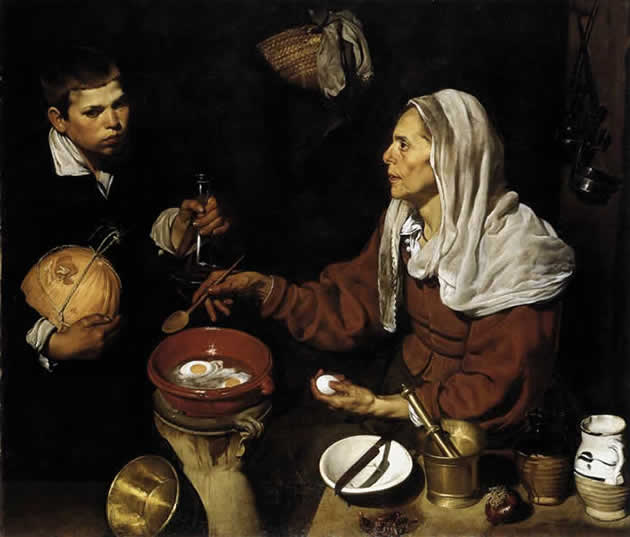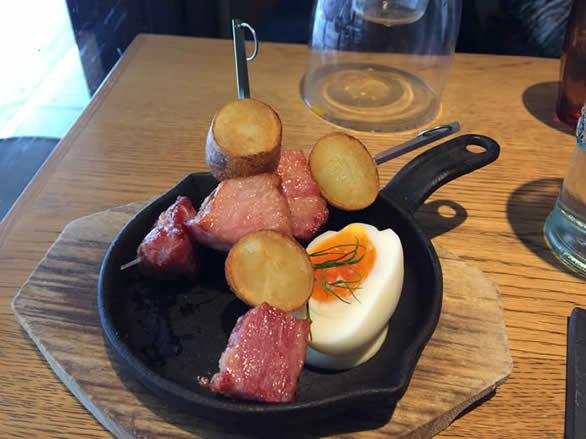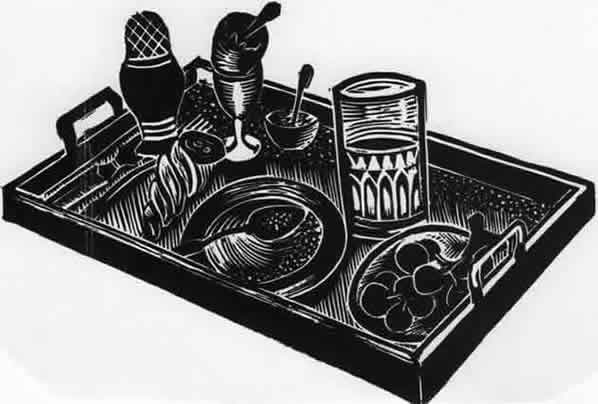EGG DISHES

Velázquez: Old woman frying eggs
Mediterranean omelettes
See also OEUFS PAR MOITIÉ on the hot starters page;; and SCRAMBLED EGGS WITH SALMON CAVIAR OR LUMPFISH ROE on the cold starters page.

Bacon and eggs Japanese style (in a station café in Kobe)
EGG TIPS
|
LES OEUFS AVEYRONNAIS (STILTON EGGS) (for 2, or 3 as a first course)
This recipe from France is designed to use Roquefort (which comes from the Aveyron), but Stilton works just as well.
3 eggs
3 tablespoons of Roquefort or Stilton grated on the big holes of the grater
2 tablespoons cream
½ teaspoon paprika
1 tablespoon butter
1 heaped tablespoon flour
200ml (approx) milk, heated
2 tablespoons concentrated tomato puree (e.g. from a tube)
salt, pepper
Boil the eggs for 10 minutes and cool in cold water for at least 5 minutes. Remove the shells and cut the eggs in half lengthwise. Delicately extract the yolks without damaging the whites. Roughly grate the cheese and mash it together with the yolks, cream and paprika. Fill the whites with this mixture, roughly moulding it so that it covers the whole cut surface of the whites. Arrange the stuffed eggs in an ovenproof dish just big enough to hold them, stuffed sides uppermost. Melt the butter in a small saucepan, stir in the flour to make a roux, then gradually add the tomato puree and milk stirring the while to make a thickish sauce. Add salt and pepper to taste. Pour this over the eggs, covering them completely. Cook in a preheated oven (gas mark 8/230° C) for 10 minutes or until bubbling and beginning to brown.
OEUFS A LA BEAUCAROISE (for 2 or 3 as a first course)
Another recipe from France.
3 eggs
2 tablespoons butter
half an onion, peeled and chopped finely
2 rashers of bacon, derinded and finely chopped
1 tablespoon flour
200ml milk (approx)
2 tablespoons grated parmesan (optional)
salt, pepper
Boil the eggs for 10 minutes and cool in cold water. Remove the shells, cut in half lengthwise, and carefully take out the yolks. Melt the onion and bacon in half the butter and add the yolks, crumbled. Cook, stirring, for a few minutes until the mixture is like a paste. Stuff the whites with it and place them in an oven-proof dish into which they fit snugly, cut side uppermost. Make a thick béchamel with the rest of the butter, the flour and the milk. Season to taste and stir in the remaining yolk, crumbled. Pour this sauce over the eggs and sprinkle the parmesan over the top (if desired – it is also nice without). Place under the grill until the surface is bubbling and beginning to go brown.
EGGS WITH SPINACH AND ANCHOVY (for 2)
An excellent light dish for lunch.
2-4 eggs
300gr spinach
30gr anchovy fillets (i.e. a small tin), chopped
1 tablespoon butter
4 tablespoons cream
grated nutmeg, pepper
Boil the eggs for 5-7 minutes; peel carefully and keep warm in some hot water. Melt the anchovy fillets in the butter on a low heat and reserve. Cook the spinach in a little boiling water until just done, and squeeze the water from it. Season with a little pepper and grated nutmeg. Divide the spinach between two plates, create hollows in the middle and place the eggs, halved, in the hollows. Stir the cream into the anchovy mixture, heat through and pour over the eggs.
“Curry” is not really a term that is used in India, where this dish would probably be called “eggs with gravy”. The yogurt is beaten to stabilise it so that it does not break up when cooked.
3-4 eggs
1 medium onion, peeled and roughly chopped
1 2-cm piece of ginger root, peeled and chopped
2-3 cloves garlic, peeled and chopped
A good pinch chilli powder
½ teaspoon turmeric
1 teaspoon tomato purée, e.g. from a tube
¼ teaspoon garam masala (optional)
125 ml Greek or Greek-style yogurt
Salt, cooking oil, green coriander to garnish (optional)
Boil the eggs for 7 minutes and put in cold water. Reduce the onion, ginger and garlic to a paste in a liquidiser or spice grinder. Heat some oil in a small saucepan and fry the paste, stirring constantly until it turns golden and the oil starts to separate out (as it sticks very easily, it is best to do this in a non-stick saucepan). Add the spices and tomato purée and cook gently for another few minutes. Beat the yogurt well and stir into the pan with some salt and the garam masala (if using). Cook gently for 5 minutes, adding a little water if necessary to loosen the sauce (it should be of a thick pouring consistency). Peel the boiled eggs and cut them in half lengthwise. Mix them carefully into the “gravy” in the pan, so that they do not break up, and cook for a further 10 minutes on a very gentle heat. Serve garnished with some chopped coriander leaves if available. Serve with rice.
Roman mosaic of a bowl of eggs, Tunisia
MEDITERRANEAN OMELETTES
All around the Mediterranean, omelettes take the form a cake or pie, cooked either on top of the stove in a frying-pan or in the oven. The Spanish tortilla is the best known, but there is also the Italian frittata, the Arab eggah, the Iranian kuku, the Turkish menemen and the Basque piperade (the last two are more like scrambled eggs). Here are four different versions.
FRITTATA WITH SPINACH AND FETA (for 2)
This is adapted from the more usual Italian version which has ricotta and parmesan instead of feta and no spices or herbs.
3 eggs
150-200gr spinach
50gr feta, crumbled
1-2 tablespoons chopped parsley or mint
1-2 spring onions, finely chopped
cumin powder, grated nutmeg, salt, pepper
The spinach needs to be cooked first, in a very small amount of water, until it has all wilted. When it is cool, squeeze as much water out of it as possible and chop it into small pieces. Beat the eggs in a bowl and add the chopped spinach, the crumbled feta, the herbs and spring onions, a big pinch of cumin powder, a grating of nutmeg, salt and pepper. Stir all the ingredients together. Line an oven-proof dish with non-stick baking parchment (as anything with egg tends stick) and pour in the mixture – it should be about 2-3cm/1 inch deep. Cook for about 20-25 minutes in an oven preheated to 180º C/ gas mark 4 – it is done when it is no longer creamy in the middle and a knife comes out clean. Best served hot, but can also be eaten lukewarm or cold.
SPANISH OMELETTE (for 2)
3 eggs
1 small to medium onion, peeled and sliced
1 medium potato (about 100gr), peeled
1 tomato (about 100gr), peeled and deseeded
3-4 rashers bacon, chopped
herbs, olive oil, salt, pepper
Boil the potato and cut into small pieces. Gently cook the onion and bacon in some olive oil until the onion is soft but not coloured. Chop the tomato into small pieces. Whisk the eggs and stir in the onion, bacon, potato, tomato, salt, pepper and a pinch of dried oregano or some chopped parsley. Heat a little olive oil in a small frying-pan and pour in the egg mixture (ideally it should be about 2 cm thick). Cook fairly gently for some 4-5 minutes (depending on thickness). Then put under a grill to brown the top (it should be still slightly moist inside). Alternatively, it can be inverted onto a plate and slid back into the pan to cook the other side. Serve either hot or lukewarm.
This is the Turkish egg dish. The basic ingredients are egg, onion, peppers and tomatoes, but many cooks add extra ingredients. This recipe adds feta, but more usual alternatives are pieces of spicy sausage or olives, and some cooks add herbs such as oregano or mint. This recipe suggests using tinned Italian tomatoes as they have more taste than the fresh tomatoes available in northern Europe, especially in the winter. But in Turkey fresh tomatoes would be used and are recommended if you have some good sweet ones. They should be skinned, roughly chopped and added with the pepper.
2 large eggs
1 medium onion, peeled and chopped
1 green pepper (not to big), very thinly sliced
2 cloves garlic, peeled and sliced thinly
1 pinch chilli powder or ½ green chilli, deseeded and finely chopped
200gr (half a tin) Italian peeled plum tomatoes, chopped
3-4 tablespoons crumbled feta
Olive oil, salt, pepper, parsley
Take a small frying pan and soften the onion in a generous amount of olive oil (it is best to do this with a lid on the frying-pan). Add the sliced pepper, garlic and chilli and continue cooking until the pepper is soft. Add the tomato, salt and pepper and continue cooking, uncovered, until the juice from the tomato has evaporated and the mixture is thick. Roughly beat the eggs and pour over the top. Stir them in and remove from the heat after a few seconds, stirring until the eggs are cooked from the residual heat of the mixture in the pan. Gently stir in the crumbled feta and serve with some chopped parsley sprinkled over the top.
PERSIAN HERB OMELETTE (KUKU SABZI) (for 2)
The kuku is a Persian version of the Mediterranean omelette. It is characterised by the addition of flour and by having a very low proportion of eggs to filling – the eggs are really just there to bind the herbs. Almost any sort of herb or green salad leaf can be used; it is a perfect way to use up unwanted portions of supermarket salad mixes. Iranian cooks often add barberries and/or toasted walnuts. Ground spices (cumin, turmeric, cardamom, cinnamon, coriander) can also be added, but only in very small quantities, so as not to overwhelm the herbs. Some cooks make it in the oven rather than on top of the stove.
2-3 eggs
3 tablespoons each chopped coriander leaves, parsley, dill leaves, chives or spring onions
3-6 tablespoons other chopped green herbs or salad leaves (eg rocket, spinach, watercress,
lettuce) or more of the above herbs (the herbs and leaves should fill a pint or half-litre measure).
1 small dessertspoon fresh or dried fenugreek leaves (if available)
1 clove garlic, peeled and finely sliced
½ tablespoon flour
½ teaspoon baking powder
Salt, pepper, vegetable oil
Whisk the eggs with the flour, baking powder, salt and pepper until any flour lumps have disappeared. Stir in the herbs, green leaves and garlic. Heat the vegetable oil in a very small frying-pan (the kuku should not be too thin - a larger pan can be used if cooking greater quantities). Pour the egg and herb mixture into the pan and cook gently for about 5-7 minutes until the underside is brown. Reverse onto a plate and slide back into the pan to cook the other side and cook for another 5 minutes or so (the egg needs to be set all through)., or else put the pan under the grill to brown the uncooked side. Can be served hot, warm or cold, if desired with a dollop of Greek or Greek-style yogurt.
EGGS WITH AUBERGINE (MIRZA GHAZEMI) (for 2)
Another Iranian dish
1 large or 2 small aubergines
6 fat garlic cloves, peeled and sliced
200-250gr ripe tomatoes
¼ teaspoon turmeric powder
1 teaspoon tomato purée
¼ teaspoon caster sugar (unless using sweet tomatoes ripened in a hot country)
1 red chilli, deseeded and finely chopped (optional)
2 eggs
Olive oil, salt, pepper
Put the aubergine whole in an oven pre-heated to 220°C/gas mark 7 and bake for 45 minutes. When cool, peel off the skin and chop the flesh. Skin the tomatoes after plunging them in water that has just stopped boiling, and cut then into small bite-sized chunks. Put some olive oil in a small (preferably non-stick) frying pan and fry the garlic slices until they are just beginning to go brown at the edges. Add the tomatoes and chilli (if using). Cook gently until the tomatoes are soft and breaking down. Stir in the aubergine pulp, tomato purée, sugar, salt and pepper and cook for another 5-8 minutes, stirring and mashing together (make sure it does not stick, especially if not using a non-stick pan). Beat the eggs and pour over the top. Continue cooking until they are just set and then stir them into the mixture. (If you prefer, the eggs can be added and kept whole, in which case finish them off under the grill and do not stir into the mixture.)
